[English] 日本語
 Yorodumi
Yorodumi- PDB-2eko: Solution structure of RUH-073, a Pseudo Chromo Domain from Human cDNA -
+ Open data
Open data
- Basic information
Basic information
| Entry | Database: PDB / ID: 2eko | ||||||
|---|---|---|---|---|---|---|---|
| Title | Solution structure of RUH-073, a Pseudo Chromo Domain from Human cDNA | ||||||
 Components Components | Histone acetyltransferase HTATIP | ||||||
 Keywords Keywords | TRANSFERASE / Chromo domain / Histone tail / Chromatin organization modifier / Structural Genomics / NPPSFA / National Project on Protein Structural and Functional Analyses / RIKEN Structural Genomics/Proteomics Initiative / RSGI | ||||||
| Function / homology |  Function and homology information Function and homology informationpeptide crotonyltransferase activity / histone H2AK5 acetyltransferase activity / histone H2A acetyltransferase activity / peptidyl-lysine acetylation / positive regulation of protein acetylation / positive regulation of mitotic sister chromatid segregation / piccolo histone acetyltransferase complex / histone H4K16 acetyltransferase activity / peptide butyryltransferase activity / Sensing of DNA Double Strand Breaks ...peptide crotonyltransferase activity / histone H2AK5 acetyltransferase activity / histone H2A acetyltransferase activity / peptidyl-lysine acetylation / positive regulation of protein acetylation / positive regulation of mitotic sister chromatid segregation / piccolo histone acetyltransferase complex / histone H4K16 acetyltransferase activity / peptide butyryltransferase activity / Sensing of DNA Double Strand Breaks / lipid droplet disassembly / peptide 2-hydroxyisobutyryltransferase activity / positive regulation of triglyceride biosynthetic process / positive regulation of attachment of mitotic spindle microtubules to kinetochore / sperm DNA condensation / peptide lactyltransferase (CoA-dependent) activity / histone H4 acetyltransferase activity / Swr1 complex / positive regulation of circadian rhythm / Impaired BRCA2 binding to PALB2 / regulation of double-strand break repair / positive regulation of innate immune response / positive regulation of aggrephagy / Cardiogenesis / regulation of hematopoietic stem cell differentiation / neural tube development / positive regulation of regulatory T cell differentiation / Homologous DNA Pairing and Strand Exchange / Defective homologous recombination repair (HRR) due to BRCA1 loss of function / Defective HDR through Homologous Recombination Repair (HRR) due to PALB2 loss of BRCA1 binding function / Defective HDR through Homologous Recombination Repair (HRR) due to PALB2 loss of BRCA2/RAD51/RAD51C binding function / protein-lysine-acetyltransferase activity / Resolution of D-loop Structures through Synthesis-Dependent Strand Annealing (SDSA) / negative regulation of interleukin-2 production / Resolution of D-loop Structures through Holliday Junction Intermediates / HDR through Single Strand Annealing (SSA) / response to ionizing radiation / mitotic spindle pole / DNA repair-dependent chromatin remodeling / acetyltransferase activity / Impaired BRCA2 binding to RAD51 / NuA4 histone acetyltransferase complex / establishment of mitotic spindle orientation / Presynaptic phase of homologous DNA pairing and strand exchange / spermatid development / positive regulation of myoblast differentiation / negative regulation of double-strand break repair via homologous recombination / histone acetyltransferase activity / histone acetyltransferase / positive regulation of double-strand break repair via homologous recombination / cellular response to glucose starvation / neurogenesis / Transferases; Acyltransferases; Transferring groups other than aminoacyl groups / positive regulation of autophagy / nucleotide-excision repair / DNA damage response, signal transduction by p53 class mediator / cellular response to estradiol stimulus / Nonhomologous End-Joining (NHEJ) / cellular response to glucose stimulus / Formation of the beta-catenin:TCF transactivating complex / double-strand break repair via homologous recombination / G2/M DNA damage checkpoint / kinetochore / DNA Damage/Telomere Stress Induced Senescence / HDR through Homologous Recombination (HRR) / cellular senescence / nucleosome / double-strand break repair / Recruitment and ATM-mediated phosphorylation of repair and signaling proteins at DNA double strand breaks / site of double-strand break / HATs acetylate histones / Processing of DNA double-strand break ends / regulation of apoptotic process / transcription regulator complex / Estrogen-dependent gene expression / Regulation of TP53 Activity through Phosphorylation / DNA-binding transcription factor binding / proteasome-mediated ubiquitin-dependent protein catabolic process / transcription coactivator activity / regulation of cell cycle / innate immune response / negative regulation of DNA-templated transcription / intracellular membrane-bounded organelle / apoptotic process / DNA damage response / chromatin binding / chromatin / positive regulation of DNA-templated transcription / nucleolus / perinuclear region of cytoplasm / negative regulation of transcription by RNA polymerase II / positive regulation of transcription by RNA polymerase II / zinc ion binding / nucleoplasm / nucleus / cytosol / cytoplasm Similarity search - Function | ||||||
| Biological species |  Homo sapiens (human) Homo sapiens (human) | ||||||
| Method | SOLUTION NMR / torsion angle dynamics | ||||||
 Authors Authors | Ruhul Momen, A.Z.M. / Hirota, H. / Hayashi, F. / Yokoyama, S. / RIKEN Structural Genomics/Proteomics Initiative (RSGI) | ||||||
 Citation Citation |  Journal: To be Published Journal: To be PublishedTitle: Solution structure of RUH-073, a Pseudo Chromo Domain from Human cDNA Authors: Ruhul Momen, A.Z.M. / Hirota, H. / Hayashi, F. / Yokoyama, S. | ||||||
| History |
|
- Structure visualization
Structure visualization
| Structure viewer | Molecule:  Molmil Molmil Jmol/JSmol Jmol/JSmol |
|---|
- Downloads & links
Downloads & links
- Download
Download
| PDBx/mmCIF format |  2eko.cif.gz 2eko.cif.gz | 494 KB | Display |  PDBx/mmCIF format PDBx/mmCIF format |
|---|---|---|---|---|
| PDB format |  pdb2eko.ent.gz pdb2eko.ent.gz | 411.8 KB | Display |  PDB format PDB format |
| PDBx/mmJSON format |  2eko.json.gz 2eko.json.gz | Tree view |  PDBx/mmJSON format PDBx/mmJSON format | |
| Others |  Other downloads Other downloads |
-Validation report
| Summary document |  2eko_validation.pdf.gz 2eko_validation.pdf.gz | 344.5 KB | Display |  wwPDB validaton report wwPDB validaton report |
|---|---|---|---|---|
| Full document |  2eko_full_validation.pdf.gz 2eko_full_validation.pdf.gz | 495.3 KB | Display | |
| Data in XML |  2eko_validation.xml.gz 2eko_validation.xml.gz | 35.1 KB | Display | |
| Data in CIF |  2eko_validation.cif.gz 2eko_validation.cif.gz | 53.9 KB | Display | |
| Arichive directory |  https://data.pdbj.org/pub/pdb/validation_reports/ek/2eko https://data.pdbj.org/pub/pdb/validation_reports/ek/2eko ftp://data.pdbj.org/pub/pdb/validation_reports/ek/2eko ftp://data.pdbj.org/pub/pdb/validation_reports/ek/2eko | HTTPS FTP |
-Related structure data
| Similar structure data | |
|---|---|
| Other databases |
- Links
Links
- Assembly
Assembly
| Deposited unit | 
| |||||||||
|---|---|---|---|---|---|---|---|---|---|---|
| 1 |
| |||||||||
| NMR ensembles |
|
- Components
Components
| #1: Protein | Mass: 9915.141 Da / Num. of mol.: 1 Fragment: Histone tail binding domain, Pseudo Chromo Domain, UNP residues 5-78 Mutation: K55R Source method: isolated from a genetically manipulated source Source: (gene. exp.)  Homo sapiens (human) / Description: Cell-free protein synthesis / Plasmid: P050905-08 / Production host: Homo sapiens (human) / Description: Cell-free protein synthesis / Plasmid: P050905-08 / Production host:  References: UniProt: Q92993, histone acetyltransferase, Transferases; Acyltransferases; Transferring groups other than aminoacyl groups |
|---|
-Experimental details
-Experiment
| Experiment | Method: SOLUTION NMR | ||||||||||||
|---|---|---|---|---|---|---|---|---|---|---|---|---|---|
| NMR experiment |
|
- Sample preparation
Sample preparation
| Details | Contents: 1.19mM Domain U-15N, 13C; 20mM d-Tris-HCl (pH7.0); 100mM NaCl; 1mM d-DTT; 0.02% NaN3; 10% D2O, 90% H2O Solvent system: 90% H2O/10% D2O |
|---|---|
| Sample conditions | Ionic strength: 120mM NaCl / pH: 7 / Pressure: ambient / Temperature: 298 K |
-NMR measurement
| NMR spectrometer | Type: Varian INOVA / Manufacturer: Varian / Model: INOVA / Field strength: 800 MHz |
|---|
- Processing
Processing
| NMR software |
| ||||||||||||||||||||||||
|---|---|---|---|---|---|---|---|---|---|---|---|---|---|---|---|---|---|---|---|---|---|---|---|---|---|
| Refinement | Method: torsion angle dynamics / Software ordinal: 1 | ||||||||||||||||||||||||
| NMR representative | Selection criteria: lowest energy | ||||||||||||||||||||||||
| NMR ensemble | Conformer selection criteria: structures with the least restraint violations, structures with the lowest energy, target function Conformers calculated total number: 100 / Conformers submitted total number: 20 |
 Movie
Movie Controller
Controller




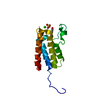

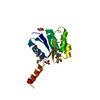
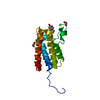
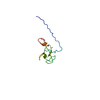
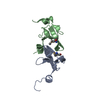
 PDBj
PDBj









 NMRPipe
NMRPipe